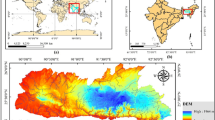Abstract
Dessie town is located in a tectonic depression along the western rift margin with a young, high energy relief. Study area is known for numerous landslides in the past. These landslides are of different types, from shallow soil creeping to huge deep-seated landslides with appreciable consequences. Landslides endanger the quickly growing regional centre of Dessie and its infrastructure. Four typical recent landslides have been selected and studied in detail using both remote sensing and field observations from 2013. The described reactivation and new landslide events have been caused by a combination of natural influences and anthropogenic activities. Since seasonal rainfall is the main external triggering factor, precipitation data from Dessie weather station were analysed. The degree of negative human impact on slope instability was also discussed. Endangered zones and the actual risk in the studied localities were identified, and adequate measures were proposed.










Similar content being viewed by others
References
Abebe B, Dramis F, Fubelli G, Umer M, Asrat A (2010) Landslides in the Ethiopian highlands and the rift margins. J Afr Earth Sci 56(4–5):131–138
Almond DC (1986) Geological evolution of the Afro-Arabian dome. Tectonophysics 131:301–332
Ayalew L (1999) The effect of seasonal rainfall on landslides in the highlands of Ethiopia. Bull Eng Geol Environ 58:9–19
Ayalew L (2000) Factors affecting slope stability in the Blue Nile basin. In: Bromhead M, Dixon N, Ibsen M (eds) Landslides: In Research, Theory and Practice. Thomas Telford, Cardiff, Wales: 101–106
Ayalew L, Vernier A (1999) Causes and mechanisms of slope instability in Dessie town, Ethiopia. In: Yagi N, Yamagami T, Jang JC (eds) Slope stability engineering. A.A. Balkema, Rotterdam/Brookfield, Rotterdam, pp 1181–1186
Ayenew T, Barbieri G (2005) Inventory of landslides and susceptibility mapping in the Dessie area, Northern Ethiopia. Eng Geol 77:1–15
Ayenew T, Geremew Z (2002) Integrated study of landslides in Dessie area. Unpublished technical report. Department of Geology and Geophysics. Addis Ababa University. 79 pp
Beyene F, Busch W, Knospe S, Ayalew L (2012) Heavy rainfall-induced landslide detection from very high resolution Multi-Aspect TerraSAR-X images in Dessie, Ethiopia. IEEE International Geoscience and Remote Sensing Symposium (IGARSS), 22–27 July 2012, Munich, Germany: Proceedings of IEEE International Geoscience and Remote Sensing Symposium (IGARSS): 1–4
Brindley GW, Brown G (1980) Crystal structures of clay minerals and their X-ray identification. Mineralogical Society, London, p 495
EIGS, Ethiopian Institute of Geological Surveys (1991) A report on engineering geological studies of Dessie town. Addis Ababa
EIGS, Ethiopian Institute of Geological Surveys (1995) A report on landslide problems of Dessie town. Addis Ababa
Eshete G (1982) Slope instability survey in Dessie town, unpublished report, Ethiopian Institute of Geological Survey, Addis Ababa
Eshetu H, Tesfaye T, Beleke Y, Lema T, Alemayehu S, Tadesse E, Kifle D, Leggesse F (2013) Engineering geological & geohazard mapping of Dese Map Sheet. Ministry of mines, Geol. survey of Ethiopia, geohazard investigation directorate, Addis Ababa
Fubelli G, Abebe B, Dramis F, Vinci S (2008) Geomorphological evolution and present day processes in the Dessie Graben (Wollo, Ethiopia). Catena 75:28–37
Gouin P (1979) Earthquake history of Ethiopia and the horn of Africa. International Development Research Center, Ottawa, 258 pp
Gregnanin A, Piccirillo EM, Abebaw E (1973) The subdivision of volcanic series in the Ethiopian plateau: new geologic interpretation of the Dessie-Kombolcha area. Bull Soc Geol It 92:307–312
Hailemariam T (1995) A report on landslide problem of Dessie town. Unpublished report of the Ethiopian Institute of Geological Surveys, Addis Ababa
Micheejev VI (1957) Rentgenometričeskij opredělitěl miněralov – S 867, Nauka Moskva
Mineral Powder Diffraction File—Data Book (1980): JCPDS USA
Mohr (1986) Sequential aspect of the tectonic evolution of Ethiopia. Mem Soc Geol Ital 31:447–461
MoWUD (Ministry of Works and Urban Development (1995) Study of landslides in Dessie town. Unpublished report of the ministry of works and urban development. Federal Government of Ethiopia, Addis Ababa
Nyssen J, Poesen J, Moyerson J, Deckers J, Mitiku Haile Lang A (2003) Human impact on the environment in the Ethiopian and Eritrean highlands—a state of the art. Earth-Sci Rev 64(3–4):273–320
Suyum (2011) Landslide mapping assessment using GIS techniques in Dessie area, northern Ethiopia—master dissertation. Universiteit Gent, Vrije Universiteit Brussel, Belgium, 110 pp
Terefe K (2001) Engineering geological mapping and landslide assessment of Dessie town. Addis Ababa University, Department of Geology and Geophysics, MSc thesis, 173 pp
Tsehayu K, Gezehegn A (1995) A report on landslide problems of Dessie town, Unpublished Report, Ethiopian Institute of Geological Survey. Addis Ababa, Ethiopia
USGS, Earthquake Archive Search, Earthquake Archive Search (last visit on 23 October 2014)
Vacondios I, Kanstantopoulou G, Karadassi ST (2007) The contribution of clay minerals in the landslides occurence within Pindos flysh formation. Bulletin of Ihe Geological Society of Greece, Vol. XXXX, 1–8
Woldearegay K (2013) Review of the occurrences and influencing factors of landslides in the highlands of Ethiopia: with implications for infrastructural development. Momona Ethiop J Sci (MEJS) V5(1):3–31
Zvelebil J, Šíma J, Vilímek V (2010) Geo-risk management for developing countries—vulnerability to mass wasting in the Jemma River Basin, Ethiopia. Landslides, Springer, Vol. 7, No 1, pp 99–103
Acknowledgments
This project was performed in the framework of the GACR project ‘Mass wasting and erosion as an indicator of morphotectonic activity in the Ethiopian Highlands based on remote sensing approaches’ (P209/12/J068) and the German Science Foundation (DFG), project ‘Integrated assessment of geomorphological process dynamics on different spatio-temporal scales in the Ethiopian Highlands using remote sensing and advanced modelling approaches’ (HO1840/11-1). The ALOS/PRISM data were provided by ESA in the framework of the project ID13160. We thank Mr. Calogero Schillaci for his help with the processing of the ALOS/PRISM data. Special thanks also go to Mr. Ali Ahmet for his valuable information on the landslide history of the Dessie area.
Author information
Authors and Affiliations
Corresponding author
Rights and permissions
About this article
Cite this article
Vařilová, Z., Kropáček, J., Zvelebil, J. et al. Reactivation of mass movements in Dessie graben, the example of an active landslide area in the Ethiopian Highlands. Landslides 12, 985–996 (2015). https://doi.org/10.1007/s10346-015-0613-2
Received:
Accepted:
Published:
Issue Date:
DOI: https://doi.org/10.1007/s10346-015-0613-2




